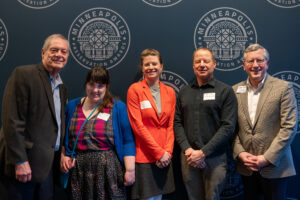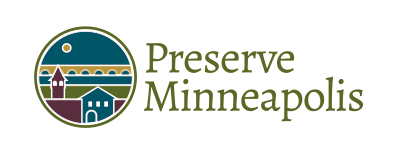Preserve Minneapolis Mission
Our History
Preserve Minneapolis began in 2003 as an informal group of professionals and enthusiasts helping to organize tours, parties, and other events in Minneapolis for the National Trust for Historic Preservation’s annual conference. Since then, we’ve evolved into a permanent 501c3 organization promoting preservation throughout Minneapolis.
The Beginning: Team 007
Preserve Minneapolis began as part of an effort to plan the 2007 annual conference of the National Trust for Historic Preservation. By 2003 the National Trust, under the leadership of Minnesotan Richard Moe, had chosen St. Paul as its 2007 conference site. But Charlene Roise of Hess, Roise and Company, who had been an advisor to the National Trust in the 1990s, says “We needed our own little subgroup in Minneapolis to make sure our city did not get left behind.” Roise says the first meeting to plan the conference’s Minneapolis component was on February 3, 2003, at the Times Bar and Café on East Hennepin Avenue. In addition to Roise, early planners of Minneapolis’s conference component included Tom Meyer of Meyer, Scherer & Rockcastle Architects; Michael Byrd of Artspace; Ann Calvert, then of the Minneapolis Community Development Agency; Chuck Liddy, then of Miller Dunwiddie Architects; Bob Mack of MacDonald & Mack Architects; and architectural designer Bob Roscoe. This group coordinated with St. Paul leaders including Bonnie McDonald, then executive director of the Preservation Alliance of Minnesota (PAM; now called Rethos); and Amy Mino and Sarah Fossen representing Landmark Center, the conference’s main venue.
Roise says the ad hoc Minneapolis committee soon agreed that the 2007 conference should not be the endpoint of its efforts. Accordingly, in addition to planning conference activities, they brainstormed ideas for ongoing programs including policy initiatives, celebrating people, and field workshops.
Also early in the planning phase, the group chose a name for itself. Roise says, “I think it was Ginny Housum who came up with the name Team 007 – and that’s what we went by for a long time.” She says that, by 2005, Team 007 had organized a home tour and had begun presenting the series of events called Breakfast With a Preservationist (later renamed Morning Forum), mostly organized by Bob Roscoe and held at Mill City Museum, which also was in its early years of operation.
After the 2007 National Trust conference, Roise stepped back from her leadership role. In 2008, the name Preserve Minneapolis was adopted and John Stark became the organization’s first president. Elizabeth “Liz” Gales, who also was on the board of directors from the group’s beginning, was instrumental in obtaining PM’s status as a 501 (c) 3 non-profit organization. The official Minnesota charter states that PM’s objectives and purposes are “to educate and advocate for preservation of architecture and related cultural resources in the city of Minneapolis, Minnesota.” Signatories to the charter were Gales, Roise, Roscoe, and Steve Budas.
Gales says that, at about the same time, it was Bob Mack who came up with PM’s logo, an image of a carved stone cartouche on the Grain Exchange Building where MacDonald & Mack’s offices are.
Tours
From its beginning, Team 007 intended to organize tours of architecturally interesting places and spaces, especially those not open to the public. Toward that end Roise says the group started a program called Cocktails With a Preservationist (later known as Happy Hour with a Preservationist and now called Evening Explorations). “The first place we got into was the landscape of The Towers Condominiums. Jean Garbarini was the landscape architect for the plaza’s renovation, and she got us in.” Other early tours included Peavey Plaza, the Foshay Tower, and the ING Building (20 Washington Ave. So., originally Northwestern National Life Insurance and now called the Voya Financial Building). Hess Roise employees Liz Gales and Penny Petersen and Miller Dunwiddie architect Denita Selchow (now Denita Lemmon) contributed to planning these events.
Conducting tours of the city’s built environment became a major component of PM’s activities in 2010 when PM partnered with the city’s Community Planning and Economic Development Agency (CPED) to manage summer walking tours, which had reduced staff as it recovered from the Great Recession. In 2011 CPED handed full responsibility for tours to PM. Tammy Lindberg and Peter Sussman managed that transition for PM. Sussman served on the tour committee before joining the board of directors in 2015 and has served as committee chair since that year. PM annually has presented about twenty-five volunteer-led architecture/history walking tours all over the city.
www.MinneapolisHistorical.org
In 2013, historical consultant Tammy Lindberg worked with Angie Nelson, Alicia Cermak, and other residents of the north Minneapolis neighborhood called Old Highland to obtain a grant from the Minnesota Historical and Cultural Heritage Program. In the same year, residents of the southeast Minneapolis neighborhood called Marcy-Holmes, including Melissa Bean, John Capecci, and Sara Shaylie, received funding from the Saint Anthony Falls Heritage Board. Both groups used their grant money to create online “tours” of their neighborhoods’ historic architecture. PM hosted these tours on a cellphone/computer app called www.minneapolishistorical.org (MH), which is based on software called Omeka. In 2016, with help from computer expert Cermak, MH committee chair and editor-in-chief Richard Kronick oversaw conversion of the app to a website (retaining the URL, www.minneapolishistorical.org), thus saving PM the cost of the app’s annual hosting fee. Kronick also recruited writers and photographers to expand MH’s content, which now contains text, images, and audio that describe hundreds of buildings and landscapes across the city.
Advocacy
Advocating for preservation of historic structures is another important aspect of PM’s ongoing program. One of the organization’s major successes in that arena has been Peavey Plaza, which had deteriorated since its opening in 1975. In response, the city and a consultant proposed a radical redesign that would have nearly flattened the plaza and greatly altered its signature waterworks. PAM and The Cultural Landscape Foundation were successful in suing to stop that plan, while Gales and Katie Haun-Schuring led PM’s efforts to advocate for a new design. That design, implemented in 2019, completed needed repairs and made the plaza accessible to people with disabilities while maintaining the landscape’s historic character.
Special thanks for board member Dick Kronick for compiling this overview of our history
Board of Directors

Jen is a native Minneapolitan, an Old Home Certified Realtor® with Keller Williams Realty Integrity Lakes, and a proud house nerd. She holds a B.A. in History from Hamline University.
As a Realtor®, Jen combines her love for history and people to help clients understand old homes—how they function, how to care for them, and how to balance preservation with the evolving needs of modern living. She believes in honoring a home’s past while ensuring it meets the demands of today and the future.
Beyond real estate, Jen is actively involved in her community, embraces volunteer leadership roles, and treasures time with friends and family. She’s also a devoted British TV lover, always ready to chat about her favorite series.
Bob Thaman, Vice President
Bob has had a life-long interest in historic preservation and has been involved with projects in a variety of roles in Minnesota and Ohio. He recently retired from owning a successful advertising business after 32 years of specializing in all media for retail marketing. He now brings his expertise to Preserve Minneapolis to help increase awareness of local preservation projects, this organization and membership.
Elizabeth “Beth” Sowden, Acting Secretary
Elizabeth (Beth) Sowden was born and raised in Northeast Minneapolis. She graduated from Sarah Lawrence College and works as a marketing copywriter. She is the author of the novel, Tough Love at Mystic Bay, and publishes stories and essays on Substack. She lives in Northeast with her mom and 70-pound Airedale named Dodger.
John, who has a master’s degree in History Museum Studies from Cooperstown, NY, was with the Minnesota Historical Society for nearly 30 years. At MNHS, he held several positions including Director of Mill City Museum, and most recently Director of Historic Sites and Museums. In that latter role, he oversaw Minnesota’s network of State Historic Sites, including Mill City Museum, Historic Fort Snelling, Split Rock Lighthouse, and 28 other properties. He also served as coordinator/secretary of the St. Anthony Falls Heritage Board and was vice-chair of the Minneapolis Preservation Commission. He currently serves as chair of the Minneapolis Riverfront Partnership, is a member of the board of the Mill City Farmers Market Charitable Fund, is president of the Minnesota State Grange, and executive director for the Hennepin History Museum.
Rebekah Coffman
Rebekah Coffman is an art and architectural historian based in Minneapolis. She received a Bachelor of Arts from Hamline University in Art History, Religion, and Spanish and a Master of Arts from New York University’s London-based program in Historical and Sustainable Architecture. She has experience in academic, museum, and nonprofit settings and is passionate about storytelling and stakeholder engagement. Her interests center on intersections between visual culture and the built environment, sites with complex shared histories, sacred spaces and religious buildings, and rural revitalization projects.
Krishna Dorney
Krishna Dorney studied History and Building Preservation at the University of Minnesota and works as a remodeling Contractor, specializing in custom carpentry and home renovation. He is particularly interested in Prairie School, Arts and Crafts and Art Deco.
David Hlavac
David is a strategic communications professional with more than 20 years of experience in cause marketing, public relations, content strategy and media engagement. A Minneapolis native with vivid memories of downtown in the 1970s and 1980s, David believes strongly that historic preservation is more than just a feel-good pursuit: it’s the very thing that keeps cities alive, vibrant and unique. David earned a Bachelor of Arts degree in American History – with an emphasis on Minnesota History – from the University of Minnesota-Twin Cities, where he enjoyed exploring every corner of Rarig Center, Ralph Rapson’s brutalist landmark on the University’s West Bank Campus.
Richard Woldorsky
Richard has been a designer at Bachman’s Landscape Department in Minneapolis for 32 years. Previously, he was an Urban Planner in the Zoning Subdivision Department of the City of Dallas, Texas. He also worked as a Land Use Planner / Landscape Architect in New England based in Concord, New Hampshire. Richard holds a Bachelor of Landscape Architecture degree and a Bachelor of Arts in Urban Studies from the University of Minnesota. He grew up in Minneapolis’ Northside in a community that can be described as “Old Urbanism,” where relatives lived nearby, kids met up on street corners, and shop owners knew many of their customers by name. His interest in preservation is guided by nostalgia, curiosity, and respect for the history and texture of the city.
